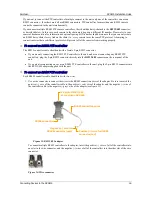
SerVision
MVG400 Installation Guide
Connecting Devices to the MVG400
18
Connecting Sensors Using an ADAM Module
If you want to connect additional dry sensors to the MVG400, you can do so by connecting an ADAM Data
Acquisition Module to the unit. Up to 16 additional dry sensors can then be connected to the unit through the
ADAM module.
NOTE:
Alternatively, you can connect additional sensors using an IA-3126-2 relay board, as explained
Connecting Sensors and Activators Using an IA Relay Board
, page 22.
To connect sensors using an ADAM module, you will need the following items:
•
ADAM-4051 Data Acquisition Module (available from SerVision)
•
ADAM-4520 isolated RS232->RS422/RS485 converter (available from SerVision)
•
Flat ribbon cable with D-type 9-pin female connector on one end and a D-type 9-pin male connector on the
other end
•
Wire to connect the ADAM module to the ADAM converter – red, black, yellow, and green
•
Wire and an electrical plug (optional) to connect the ADAM module to a power source
Figure 16: ADAM-4051
module
Figure 17: ADAM-4520 isolated
converter
NOTE:
The instructions below explain how to connect sensors to the MVG400 using the ADAM module and
converter described above. For additional information about connecting and configuring the ADAM
module and converter, please refer to the manufacturer's documentation, or contact your vendor.
To connect sensors using an ADAM module:
1. Install the sensors in their desired locations in accordance with the manufacturer's instructions.
2. Connect the wire contacts of each of the sensors to the terminal blocks of the ADAM-4051 module as follows:
•
•
•
Connect all of the negative (-) wires of all of the sensors to one of the ground (
D GND
) connectors on the
ADAM module. If the wires cannot all be inserted into the connector, use a wire connector to connect
them together, and then connect the wire connector to the ground (
D GND
) connector on the ADAM
module.
•
•
•
Connect each of the positive (+) sensor wires to one of the numbered connectors (
D1 0
through
D1 15
) in
the terminal blocks of the module.
















































